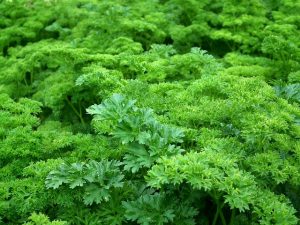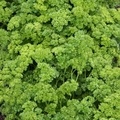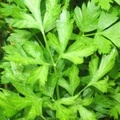Parsley (Petroselinum crispum L.) is one of the great herbs of cuisine and enhances any culinary dish. It is commonly found in combination with chervil and tarragon as it forms one of the ‘herbes fines’ and is a key ingredient in a ‘bouquet garni’. The great flavour means it is often used as a garnish or chopped into sauces, dressings, stuffings and butters. It is the main ingredient in both tabbouleh and salsa verde, and in superb white fish sauces.
Can be grown as a low hedging plant for the herb garden, or in a pot on the windowsill. Grow indoors and it is possible to harvest this herb all year round.
Nutritionally, it is full of vitamin C. In more ancient times it was used like dandelion leaves as a diuretic. A hair lotion can be made from this herb. It is used for the killing and removal of head lice and was a common and much needed application in medieval times. Parsley oil is also an important supplement in certain medications.
The flat leaved variant is generally preferred to the curly-leafed type in European cuisine because of its stronger flavour although the latter often finds its way onto the dish as the main accompaniment to fish. The plant is a biannual. In its second year it produces small white umbel like flowers. The flat leaved variety grows to 60cm height with a 30cm spread whilst the curly leaved form is shorter with a 40cm height (same spread).

Sowing Parsley Seed
Seed can be sown in open ground throughout the year although it will not send up its shoots until March when the soil begins warming up. Be patient! The seed can take up to two months to germinate so it is best to grow it on ground which is weeded thoroughly. We usually sow thinly outside from March to August where they are to crop, at a depth of 1cm. Seedlings should appear in 28 days when sown during these particular months.
Plant in rows, allowing 30cm between each to prevent overcrowding. You can sow seeds thinly inside the greenhouse from January to February in 7.5cm pots of good gritty seed compost. Place in a propagator or sealed inside a polythene bag. Keep at a temperature of 18 to 20°C until germination occurs.
Seed sown under glass might be more straightforward and it does not need a propagator ! Given that germination can take a month or more, just sow a few more seeds than you think necessary. I’ve had better success with plugs because the plant starts forming a taproot quite soon and transplanting is best when the herb is left undisturbed.
When large enough to handle, thin seedlings to 23cm apart. Acclimatise to outdoor conditions before planting outside, in a pot or container.
It was said to be bad luck to sow this herb – a superstition borne out by the need for the herb to disguise the smell of rotting flesh.
Ongoing Cultivation Of Parsley
Planting in open ground or containers is no great deal. I prefer containers because they lend a souciant air to the planting and the curly-leaved variety is as decorative as it is flavoursome.
Plants once established, need to be kept well watered, especially during the hot, dry season of summer. I don’t tend to fertilise the plant although a boost with a balanced seaweed fertiliser helps every few weeks.
Small white umbels of flowers are produced from late July onwards. The flower heads are removed in late summer although given its annual nature, it is helpful to broadcast the seed from the dried flowers. Lower shoots can be snipped off when they turn yellow.
Harvesting Parsley
Single stems and leaves are cut with scissors to be used as fresh. Generally, parsley is cut from January through to December if there is enough growing. Generally thought, the best harvest is between June and October.
Parsley leaves are frozen or dried for use during leaner times in the year. I bring plants in pots into the greenhouse just before frosts so that the plant continues to provide enough herb during the leaner months.
Varieties:-
Flat-leaved varieties make for tender eating and the large harvests of the type ‘Gigante d’Italia’ often cover the pastures of France and Italy.
French parsley: – Dark green, flat leaves with great flavour. Ideal for Italian dishes.
cv. ‘Champion‘ -a real champion of the herb world where it boasts fine, tightly curled and dark-green leaves.
cv. ‘Envy‘ AGM: – Dark green, densely curled leaves.
cv. ‘Gigante Napoletano’: – Large, flat and aromatic leaves. The variety ‘Gigante d’Italia’ must be sought out too.
‘Plain Leaved 2’: – Flat leaves with a strong flavour.


Please note this article contains links to our affiliate marketing partners. Please read our affiliate disclaimer.
Purchase your Parsley Seeds here